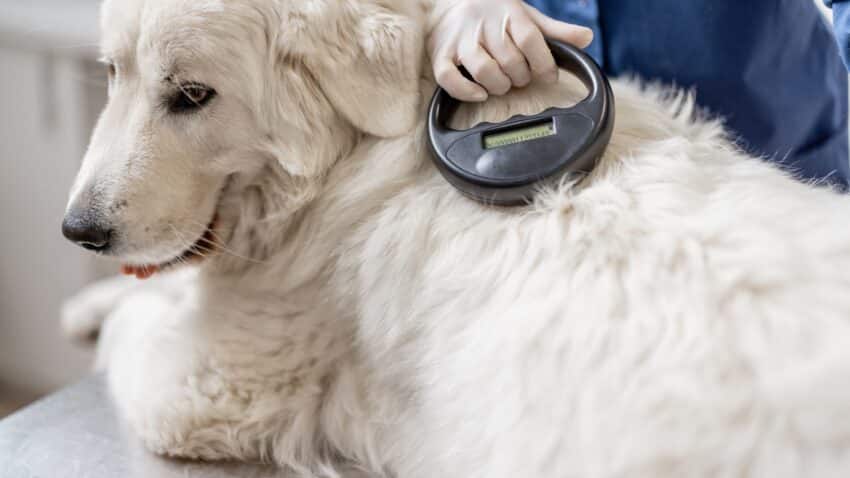
Q: What is a microchip?
A: A microchip is a small, electronic chip also known as a transponder, enclosed in a glass cylinder the size of grain of rice. Microchips do not have batteries, but emit low frequency radio waves (frequencies used in the U.S. include 125 kilohertz (kHz), 128 kHz, and 134.2 kHz.) which are only activated by a scanner when passing directly over the chip. An identification number is relayed to the scanner.
Q: Why should I have my animals microchipped?
A: The best reason to have your animals microchipped is the improved chance that you’ll get your animal back if it becomes lost or stolen.
Q: How is a microchip implanted into an animal?
A: A microchip is injected under the skin using a hypodermic needle. Anesthesia and/or surgery are not necessary and it is no more painful than any other typical injection, the needle is slightly larger than those used for typical injections. They are often implanted during routine veterinary office visits.
Q: What kind of information is stored on a microchip? Does it track my pet?
A: Most microchips used in domestic pets only contain an identification number. The microchip is not a GPS device and does not track your pet. Many of the microchip companies do offer online databases where you can store and update information on your pet and how to contact you if found. The chip itself does not contain any information other than the ID number. There are no concerns of “hacking” a microchip or using information from the chip to do anything other than contact the pet owner.
*** Having the microchip implanted is only the first step! The microchip must be registered to give you the best chances of getting your pet back if lost. Without that correct and current information in the registration database, your chances of reuniting with your pet are dramatically reduced. ***
Q: How does a microchip reunite you with a lost animal?
A: When a stray animal is found and taken to a shelter or veterinarian, they are scanned for a microchip. If a microchip is discovered and it has been registered with accurate and up to date information, the person connected to the registered ID is contacted.
Fact: 1 in every 3 pet dogs will at some point escape and be found as strays. A study of more than 7,700 stray animals at rescue shelters in 23 states showed that microchipped animals are far more likely to be returned to their owners. In that study, microchipped stray dogs were returned to their owners at more than double the overall rate for all stray dogs (both microchipped and not microchipped). For stray cats, the difference in return rates was even more dramatic. Microchipped animals that weren’t returned to their owners, the most common reason was incorrect contact information in the microchip registry database. Do not forget to register your microchip, and be sure to update your contact information often.
Q: Does a microchip replace ID and rabies tags?
A: In short, No. Microchips are great tamper proof, permanent identification that is accessible to Veterinarians and shelters. A collar with up-to-date identification tags is often the quickest process to contact the owner; of course, the information on the tags must be accurate and up-to-date. If a pet is not wearing a collar and tags, or if the collar is lost or removed, then the presence of a microchip might be the only way the animal’s owner can be found. Rabies tags should always be on your pet’s collar, so they can quickly be identified as vaccinated for this deadly disease. Rabies tag numbers are also a way of tracing the identification of a lost animal’s owner by contacting veterinary clinics or town offices, but these are typically closed on nights and weekends, microchip databases are online or telephone-accessed 24/7/365.
Q: Where do I go to get my pet microchipped?
A: Here at Monadnock Humane Society of course, https://monadnockhumanesociety.org/vaccination-microchipping/
Or your veterinarian, it is likely that your pet can be implanted with a microchip the same day as a regular appointment.
Q: Are there any concerns or problems associated with microchips?
A: The British Small Animal Veterinary Association (BSAVA) maintains a database of adverse reactions to microchips. Since its inception in 1996, over 4 million animals have been microchipped with only 391 adverse reactions reported. Migration of the microchip from its original implantation site is the most common reported. Other issues include failure of the microchip, or hair loss, infection, swelling, at the injection site. Tumor formations have occurred in extremely rare cases.
Q: Does a microchip require any “maintenance”?
A: Once the microchipped is inserted, there are three things you need to do:
1) Register the microchip with up to date contact information.
2) Once a year have your veterinarian scan your pet’s microchip to make sure it is functioning and is detected.
3) Annually check the online database to ensure your registration information is up to date.
*** Although the presence of a microchip is not a 100% guarantee that you will get your pet back if it’s lost or stolen, it does dramatically increase the chances you will be reunited with your pet as long as you keep the registration information up to date. ***


